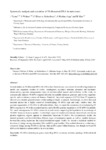Mostrar o rexistro simple do ítem
Systematic analysis and evolution of 5S ribosomal DNA in metazoans
| dc.contributor.author | Vierna Fernández, Joaquín | |
| dc.contributor.author | Wehner, Stefanie | |
| dc.contributor.author | Höner zu Siederdissen, Christian | |
| dc.contributor.author | Martínez-Lage, Andrés | |
| dc.contributor.author | Marz, Manja | |
| dc.date.accessioned | 2017-07-10T08:56:47Z | |
| dc.date.available | 2017-07-10T08:56:47Z | |
| dc.date.issued | 2013-07-10 | |
| dc.identifier.citation | Vierna J, Wehner S, Höner zu Siederdissen C, Martínez-Lage A, Marz M (2013). Systematic analysis and evolution of 5S ribosomal DNA in metazoans. Heredity 111: 410–421. https://doi.org/10.1038/hdy.2013.63 | es_ES |
| dc.identifier.issn | 0018-067X | |
| dc.identifier.issn | 1365-2540 | |
| dc.identifier.uri | http://hdl.handle.net/2183/19236 | |
| dc.description.abstract | [Abstract] Several studies on 5S ribosomal DNA (5S rDNA) have been focused on a subset of the following features in mostly one organism: number of copies, pseudogenes, secondary structure, promoter and terminator characteristics, genomic arrangements, types of non transcribed spacers and evolution. In this work, we systematically analyzed 5S rDNA sequence diversity in available metazoan genomes, and showed organism-specific and evolutionary-conserved features. Putatively functional sequences (12 766) from 97 organisms allowed us to identify general features of this multigene family in animals. Interestingly, we show that each mammal species has a highly conserved (housekeeping) 5S rRNA type and many variable ones. The genomic organization of 5S rDNA is still under debate. Here, we report the occurrence of several paralog 5S rRNA sequences in 58 of the examined species, and a flexible genome organization of 5S rDNA in animals. We found heterogeneous 5S rDNA clusters in several species, supporting the hypothesis of an exchange of 5S rDNA from one locus to another. A rather high degree of variation of upstream, internal and downstream putative regulatory regions appears to characterize metazoan 5S rDNA. We systematically studied the internal promoters and described three different types of termination signals, as well as variable distances between the coding region and the typical termination signal. Finally, we present a statistical method for detection of linkage among noncoding RNA (ncRNA) gene families. This method showed no evolutionary-conserved linkage among 5S rDNAs and any other ncRNA genes within Metazoa, even though we found 5S rDNA to be linked to various ncRNAs in several clades. | es_ES |
| dc.description.sponsorship | DFG, German Research Foundation; MA-5082/1 | es_ES |
| dc.description.sponsorship | Austrian Science Fund; SFB F43 RNA | es_ES |
| dc.language.iso | eng | es_ES |
| dc.publisher | Springer Nature | es_ES |
| dc.relation.uri | https://doi.org/10.1038/hdy.2013.63 | es_ES |
| dc.subject | 5S rRNA | es_ES |
| dc.subject | Homologous genes | es_ES |
| dc.subject | Noncoding RNA | es_ES |
| dc.subject | Secondary structure | es_ES |
| dc.subject | Paralogs | es_ES |
| dc.subject | Birth-and-death evolution | es_ES |
| dc.title | Systematic analysis and evolution of 5S ribosomal DNA in metazoans | es_ES |
| dc.type | info:eu-repo/semantics/article | es_ES |
| dc.rights.access | info:eu-repo/semantics/openAccess | es_ES |
| UDC.journalTitle | Heredity | es_ES |
| UDC.volume | 111 | es_ES |
| UDC.issue | 5 | es_ES |
| UDC.startPage | 410 | es_ES |
| UDC.endPage | 421 | es_ES |
Ficheiros no ítem
Este ítem aparece na(s) seguinte(s) colección(s)
-
GI-GIBE - Artigos [75]






